A brief informal picture page with emphasis on the
technical stuff.
blueEnergy was started in 2003 by a bunch of dedicated guys and is
still there doing its thing in Bluefields, Nicaragua in spite of all
obstacles.
It's the only small wind NGO project I know that has long term
commitment and a chance of creating a sustainable small wind industry.
On the left, a large 2 MW wind turbine in a project under construction
south of Managua. With
blueEnergy
Mathias
Craig on the way to Bluefields.
The easy way to get there is by small plane. The other way is an
overnight bus journey and a couple of hours in a boat from Rama.
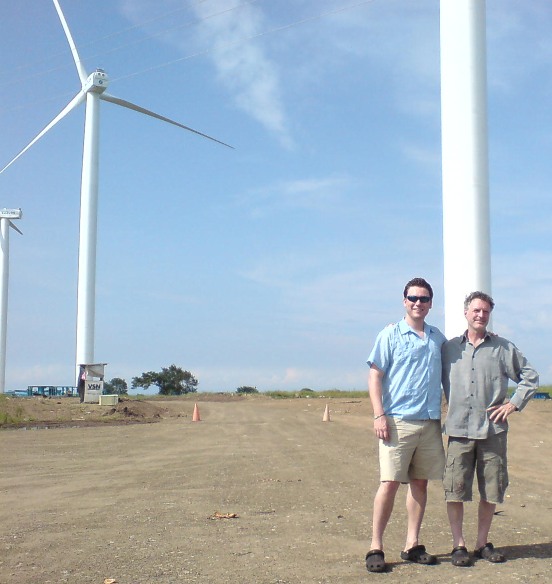
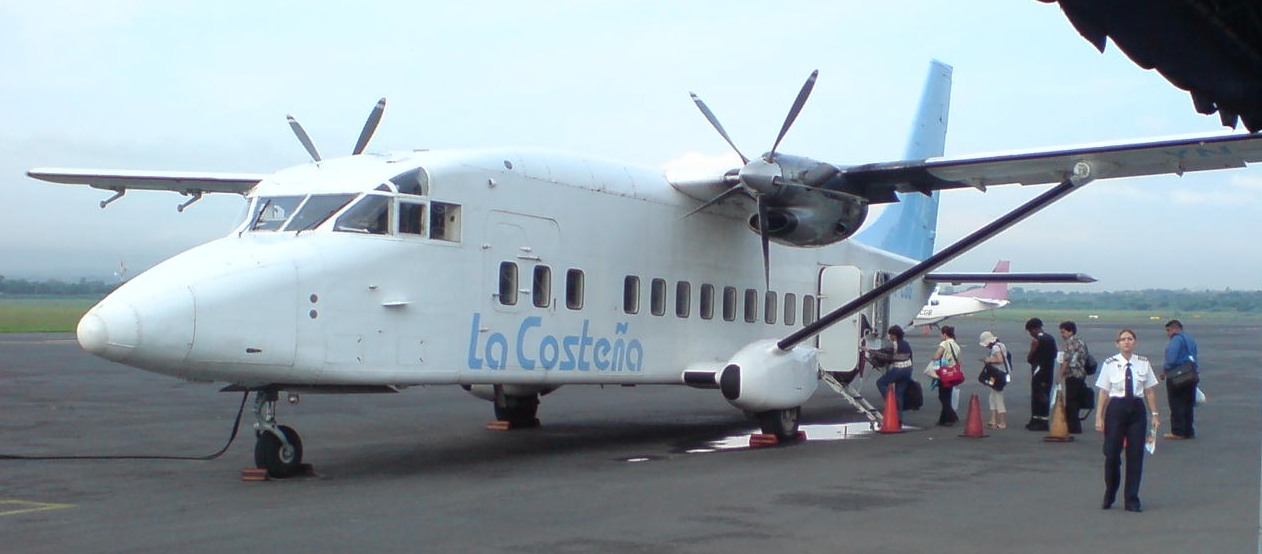
This map shows the location of Bluefields and
also
Monkey Point where I was lucky
enough to
spend a weekend.

There are a lot of people, and there is a lot going on at
blueEnergy.
They don't produce a lot of wind turbines but they
certainly keep pretty busy infrastructure building, institutional
building, community relations, training, communications.
Below/left is a picture of the dining area
behind their main house in Bluefields.
English is the main language spoken but
most of the volunteers are French.
Others come from Ireland,
Ecuador, Australia, Belgium, Texas, etc...
Also in the photo
Lâl
Marandin from bE France on a visit - nice to meet Lal again.
The right hand (black and white) photo shows the engineering
team.
I am hoping they will roll up their sleeves and make a lot
of windmills in the near future.
It's time to do something with
all that talent and workshop space.
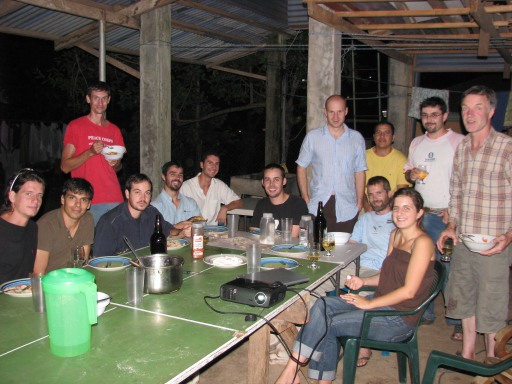

blueEnergy have expanded their workshop and office space at
IPCC-INATEC, the Bluefields campus of INATEC.
It's a technical institute, with students from 14 - 18 years old
In
an increasingly close liaison, blueEnergy are assisting with
development of a new renewable energy curriculum at the Inatec
campus.
While I was there (second week) they held a groundbreaking conference
that brought together many of the key players in renewable energy and
education in Nicaragua, to discuss common challenges and areas for
co-operation.
Shortly after I arrived they took down the test tower to check on the
'blueDiamond' turbine that was built with
Otherpower back in February.
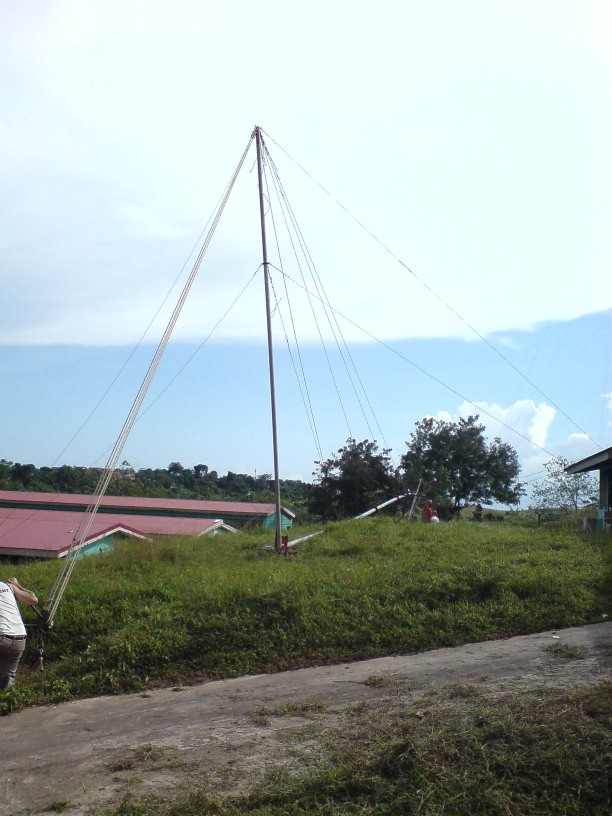
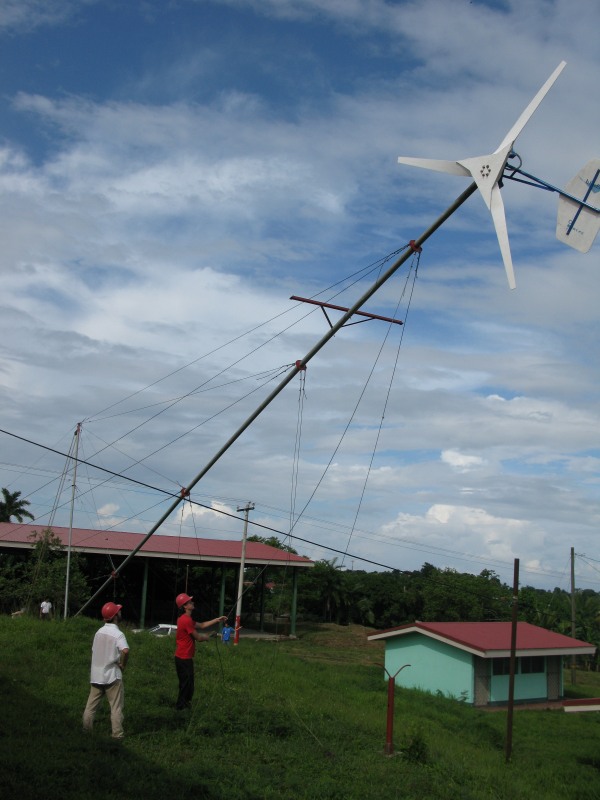
On this site they use a landrover to pull the tower up. It's
actually a pretty smooth operation, using pulleys. Seems to take
a bit of setting up (getting access to the landrover and rigging it all
etc) but it's not too stressful once it gets going. You can lower
the tower without a vehicle, just passing the rope around a post for
instance as a brake, but this wears the rope out pretty fast, so it's
not recommended. blueEnergy use this pulley system for all their
tilt-up towers, but in most cases they need a big crew of people.
The basic idea comes from
Durika in
2005.
It's a great community experience doing it with a bunch of people but
it does take a bit of organising.
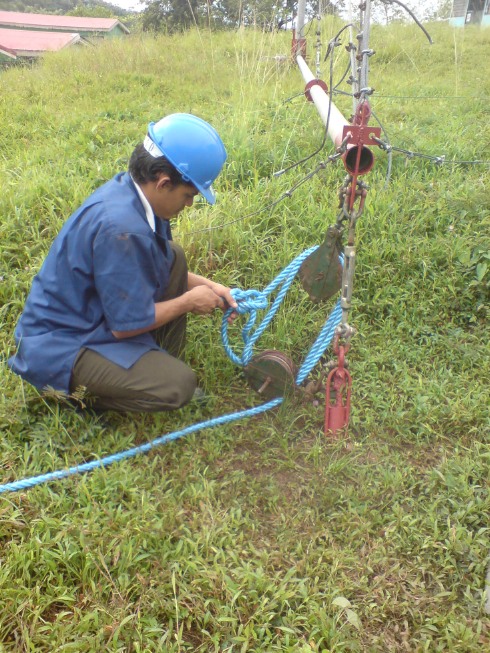
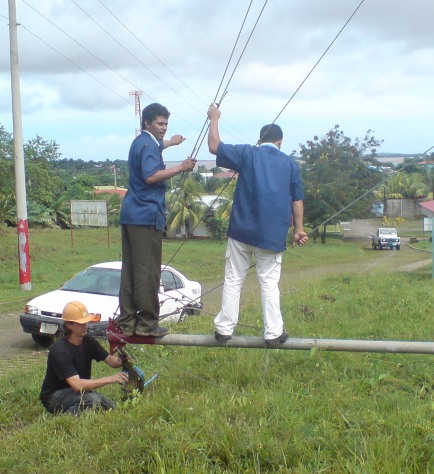
The blueDiamond was basically in good shape. It's a twelve foot
scaled up version of the Otherpower ten footer machine. Since
this one, Otherpower have built a couple more twelve footers in the
USA. The main difference between the Otherpower 12 footer and the
older ones built by blueEnergy is the choice of magnets. This
turbine uses 16 of their 2" diameter x 1/2" thick disc magnets.
(The ten footer uses only 12 of them. ) The blueDiamond (twelve
footer) magnet rotor is 14 inch diameter. There are 37 turns per
coil for 120 rpm cutin at 24 volts.
I have been using 16 inch magnet rotors for twelve foot turbines
lately. On this visit we built one like that using 16 N45 2"x1"x
1/2" magnets, and 42 turns per coil giving a 130 rpm cut-in speed.
Here you can see Clément Joulain (who has built my style
of turbines in Senegal) and Ronald (the blueEnergy workshop manager)
checking the turbine.
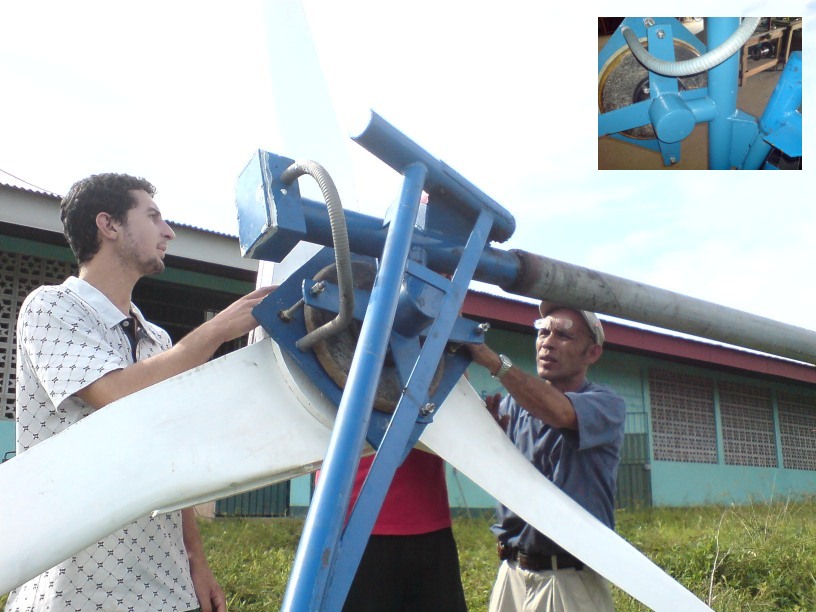
The blueEnergy 12 foot blade design is the one I used For the SEI
courses in
2004 and
2007,
and also at
Durika.
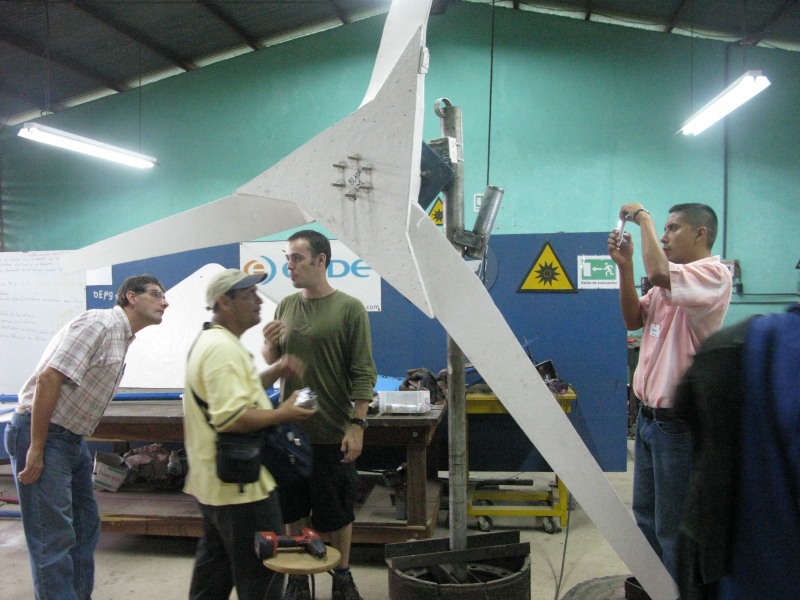
During the conference, we got a long way toward making a new set of
blades for
the Durika community. Here you can see Jaime of Asofenix getting
stuck in with the power saw.
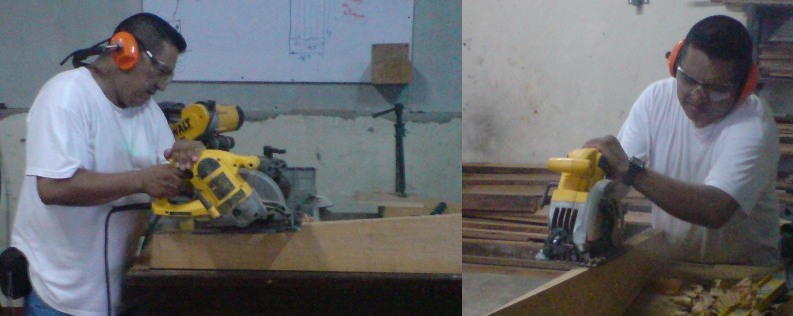
We also embarked on an experimental laminated blade using my newer
design (
Recipe book 3600 size)
same as previous courses this year in
Ireland and
Wales
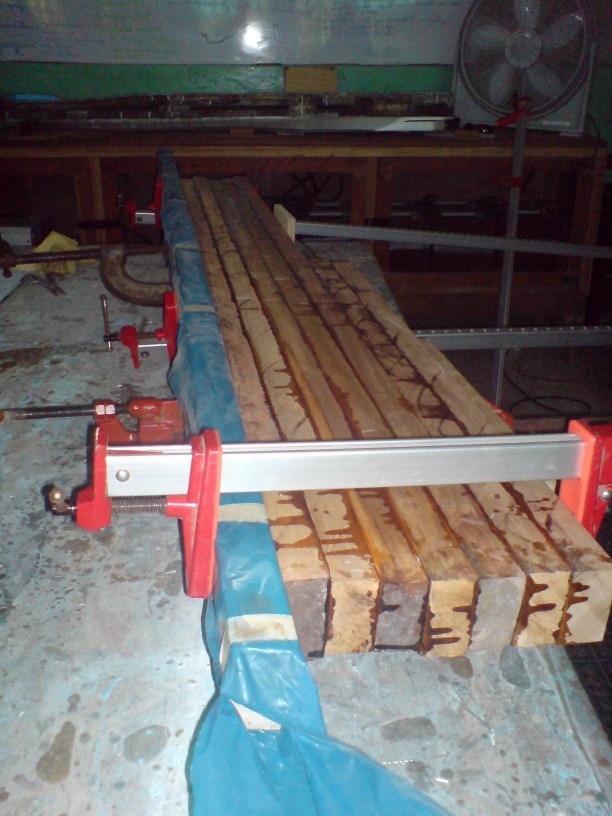
Following my suggestions, the blueEnergy team modified the
'blueDiamond' frame (to the latest 'bluePiggott'),
by angling the Otherpower tubular structure forward to
push the alternator further forward as well as further to the side (200
mm offset).
I prefer to limit the output to 1000 Watts in spite
of the improved alternator designs that we are using.
The ambient
temperatures around Buefields are quite high and there is not much to
be gained from the occasional high wind anyway.
It's interesting to look at the
problems
with the latest Otherpower version of this design as reported on
their
message board recently.
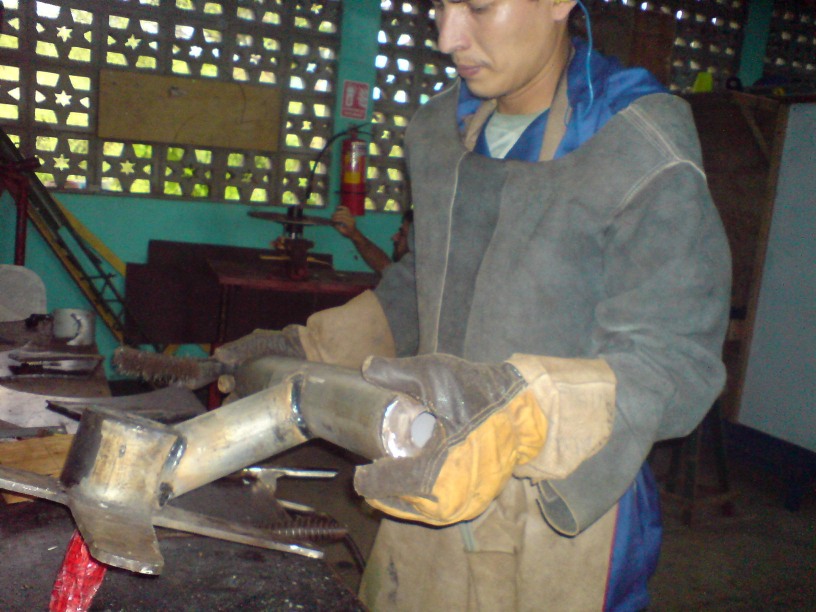
16 inch magnet rotors using 16 N45 2" x 1" x 1/2" blocks.
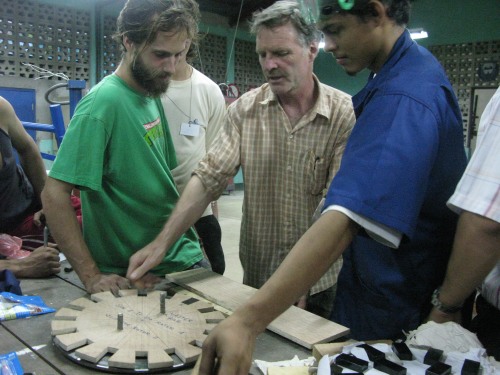
blueEnergy are very careful to avoid
breathing styrene monomer
fumes.
Here they are casting a stator for the new 16 inch alternator.
Aided by some guys from pacific coast and Managua renewable energy
businesses visiting
for the conference.
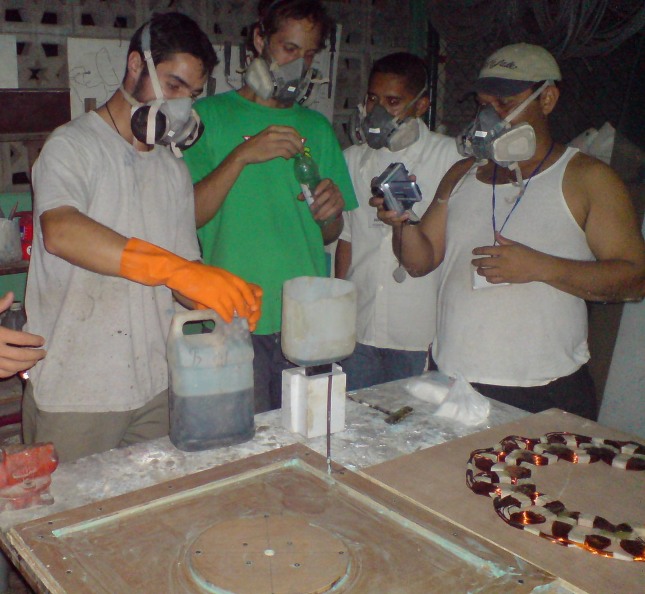
The stator mould includes a heavy duty press
made of steel with huge
wing nuts.
We had to turn it diagonally to fit the larger stator.
It allows you to put a pretty alarming amount of pressure on so that
the wires across the ends of the coils make deep marks in the plywood
surface.
In the end the stator still came out 15 mm thick because of varying
quality of coils (wound 42 turns of 2@#13 wires)
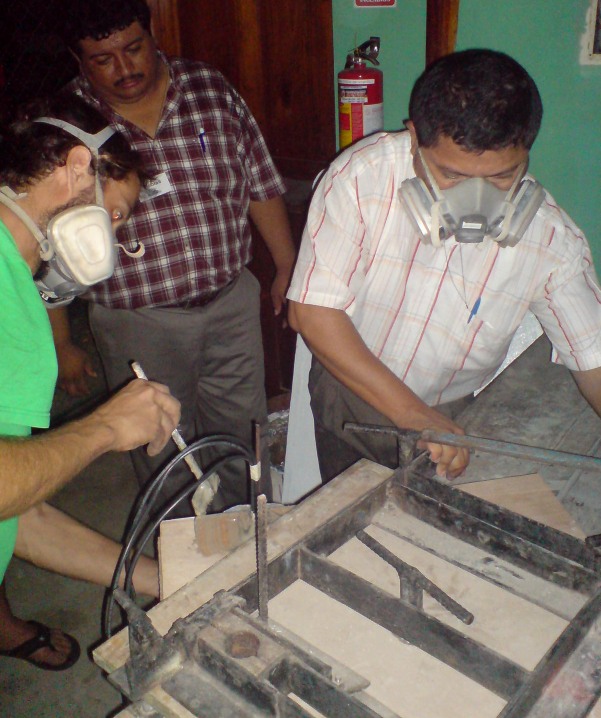
Johno of blueEnergy drills the stator mounts.
The trademark diamond-shaped stator has a lot of room in the corners,
and we didn't make best use of it with these short mounting arms.
Next time...
Note that this frame furls to the left, unlike most that furl to the
right. Again this is my recipe, to reduce danger of blade tips
hitting tower.
Not a new idea to blueEnergy, as the
Monkey
point
turbine is also left furling.
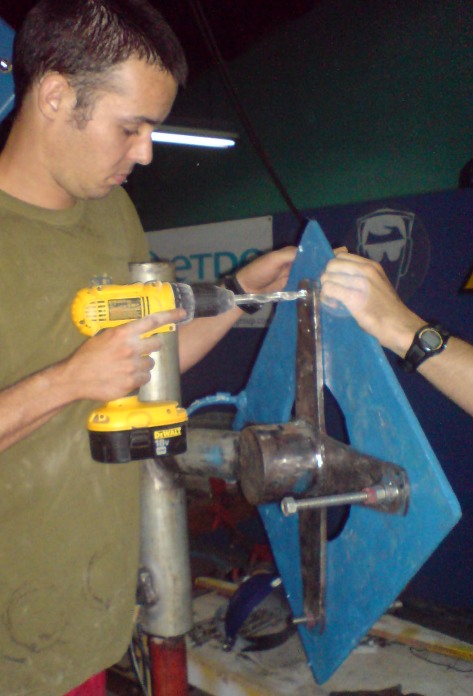
Octavio assembling the alternator
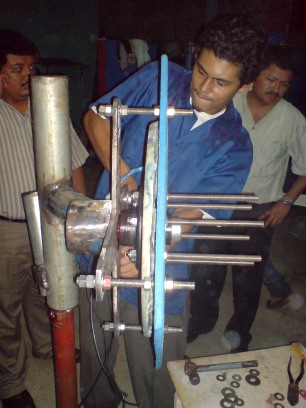
Gerson posing with the finished assembly. I am not sure about
that wiring box.
We plan to make a cover for the top of the yaw bearing and fit the
wiring connections in there.
Note the hoop on the top of the yaw bearing for supporting the wiring
that goes down the tower.
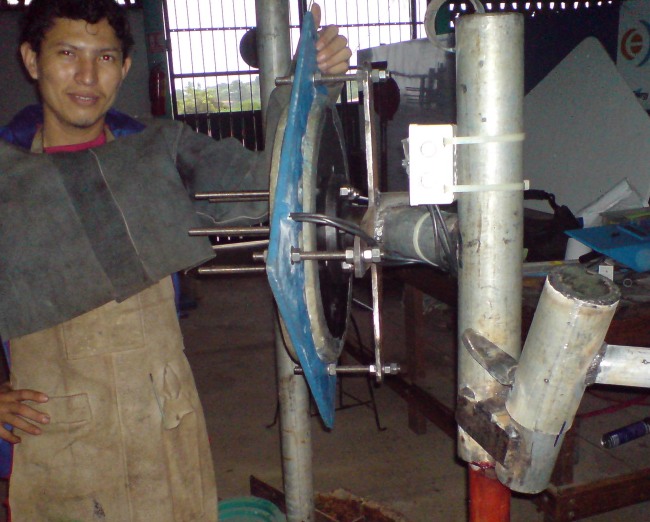
Johno and Ronald. Note the tail hinge
is done to my recipe this
time, in contrast to the Otherpower style.
Seems simpler and stronger, using bigger pipe sizes, a box-shaped
support, and external stops on the tail (no notch).
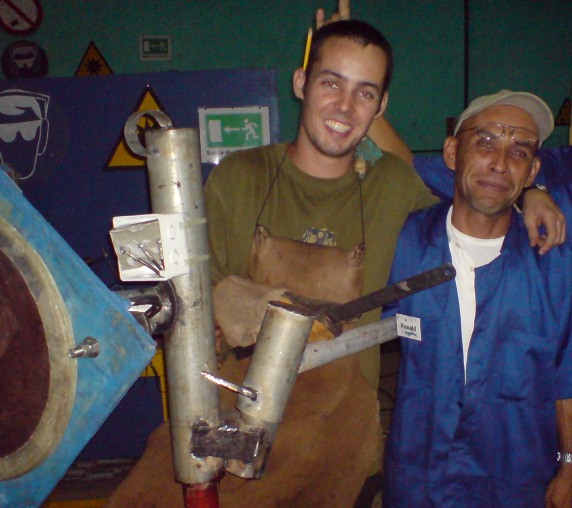
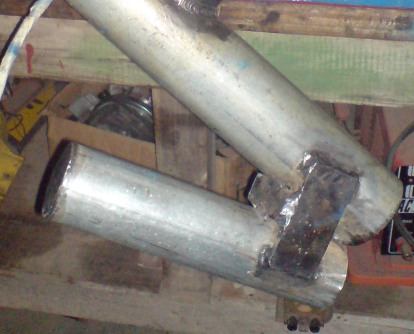
Olivier beside the bench test rig.
We got 130 rpm cut-in (24 volts), but in the end the air gap clearance
was disappointingly small.
Magnet rotors were very crude flame cutting 1/4" plate. Thin and
warped.
My feeling is that they have to use #14 wire to get more turns into the
stator if they are to achieve acceptable clearances in this workshop
environment.
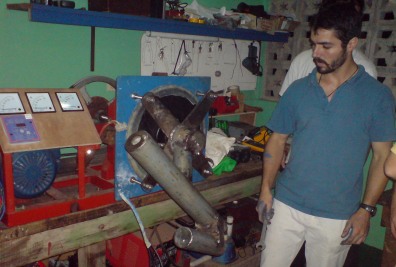
In the end the yaw bearing did not fit the tower top. The
tower-top pipe had been built up to minimise slop between pipes.
Ronald grinds the inside of the yaw bearing, and Denver Grinds the
tower-top. Got it moving freely.
Actually it is best if there is a sloppy fit. If it rattles, then
balance the blades.
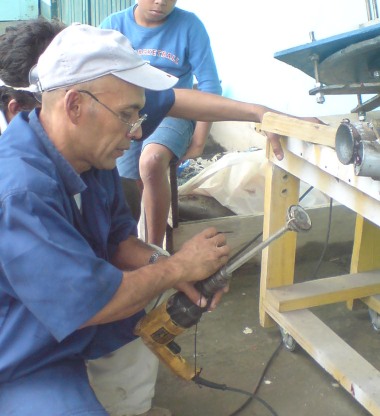
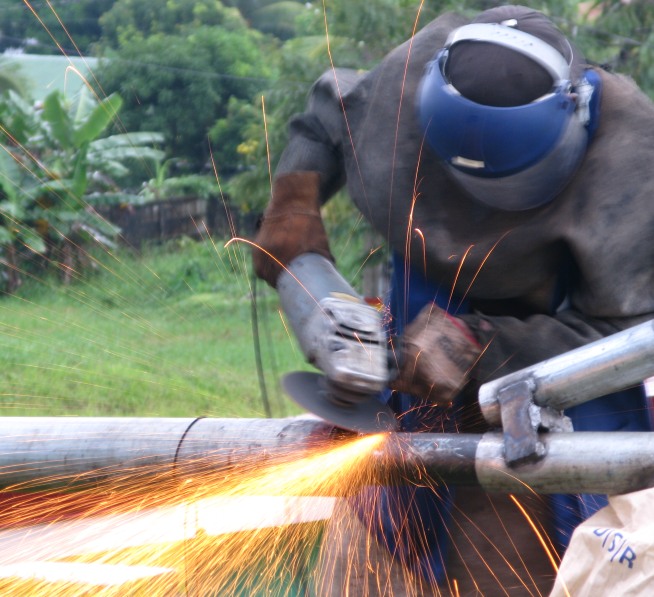
Guillaume
Craig of blueEnergy and Geronimo of UNI
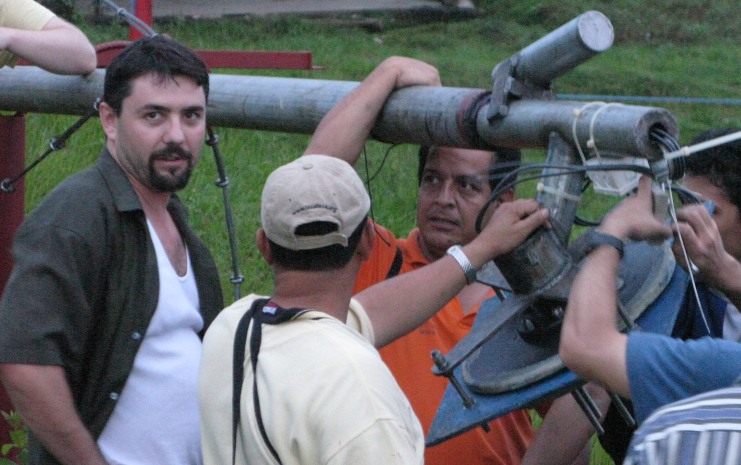
Putting the blades on with the machine horizontal. This can be a
lot easier than with the tail hanging down.
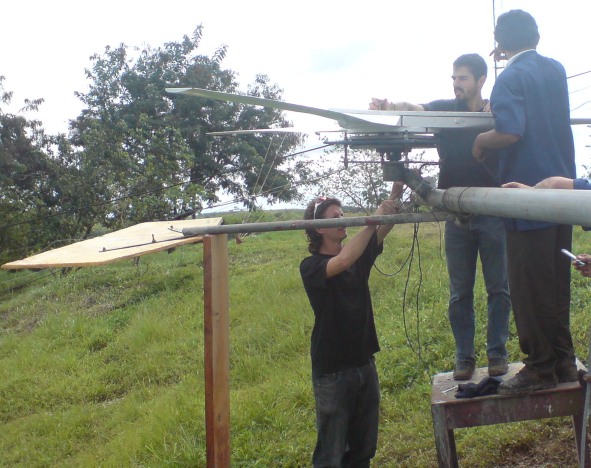
(NOTE: Take care that the tail does not slip off its hinge, when
supporting the turbine in this way.
It would be handy to have a small tab or lug welded to the yaw bearing
pipe just above
the tail's upper stop.
This would prevent the tail from sliding off once it reached the fully
furled position,
and could have prevented the sort of accident experienced by the
Otherpower turbine recently.)
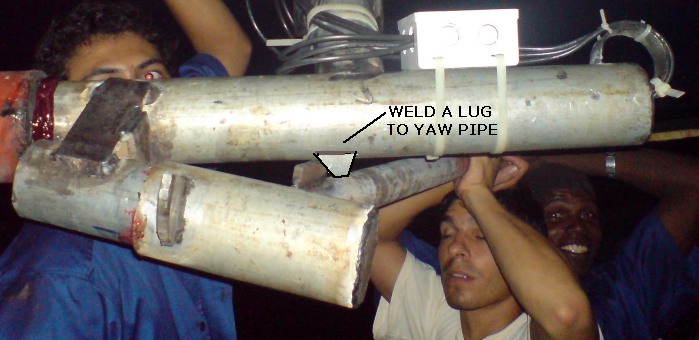
Seb and Olivier with the new concept foam tail vane. The sheet of
foam is clad in a GRP (glass reinforced polyester) skin.
There have been big problems with poor quality plywood falling apart.
I am not sure this foam is suitable as it is hygroscopic but it is
light and strong, and a good start toward a solution.
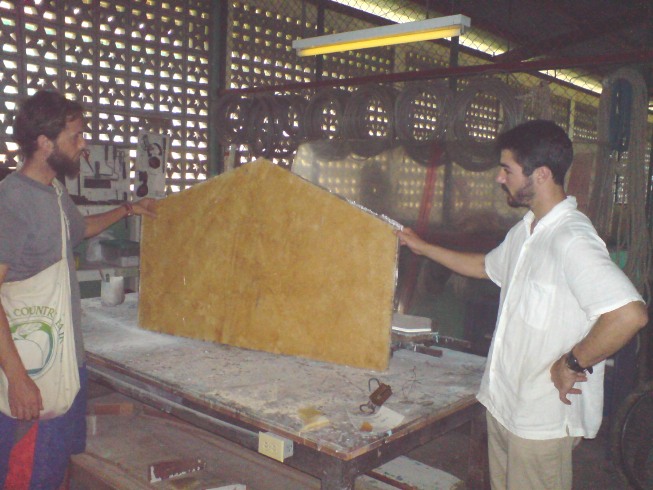
The Inatec site with the test tower flying the new blueDiamond with 16
inch rotor.
Behind is the 'Gyreum' version from February on a tower further up the
hill.
There is also a third (lattice) tower. Plenty of scope for
testing prototypes!
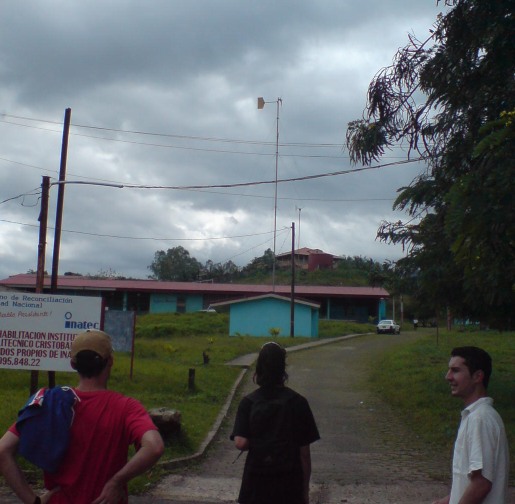
The blueEnergy conference room at Inatec.

The group photo from the larger conference that took place during the
second week of my stay.
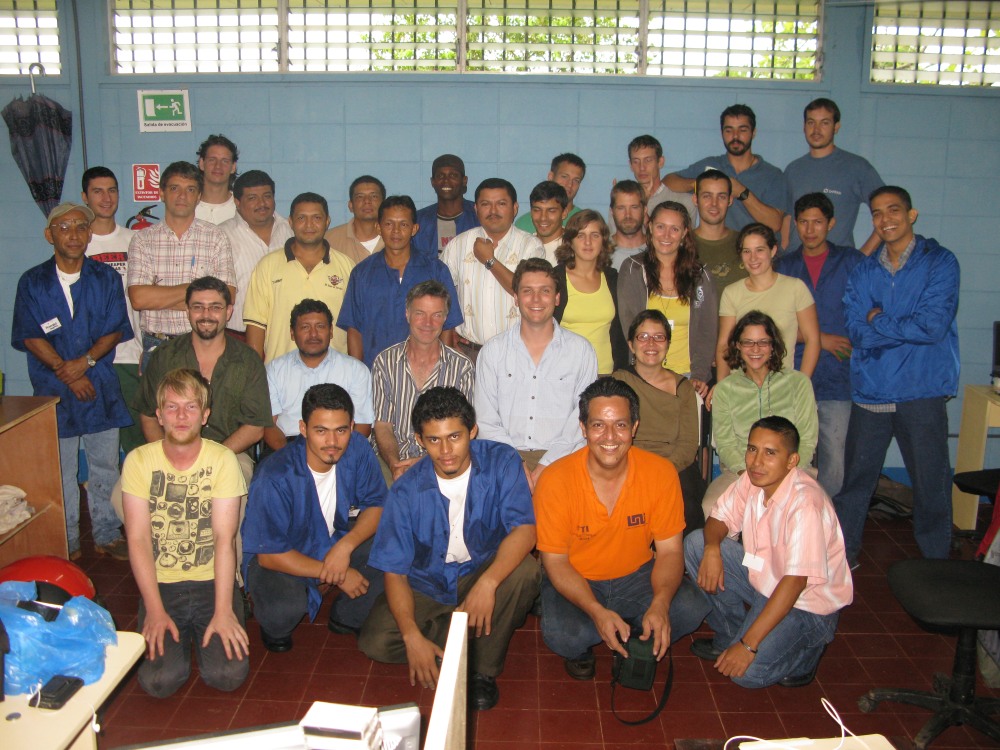
At the end they handed out wooden windmills.
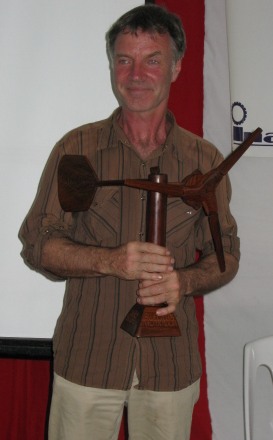
Thanks, blueEnergy for welcoming me into your busy lives.
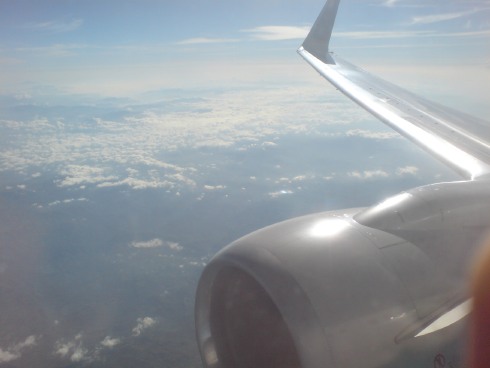
Flying home I could not help wondering how much energy in jet fuel is
used by people travelling to and from bE compared to how much energy is
produced by small wind turbines in the indigenous communities. I
feel that there is a blind spot somewhere that arises from denial about
the consequences of our uses of energy. blueEnergy is at least as
much about relationships between people as it is about engineering
solutions to energy needs. The people of our world have to work
together to find a way forward that includes everyone.





































